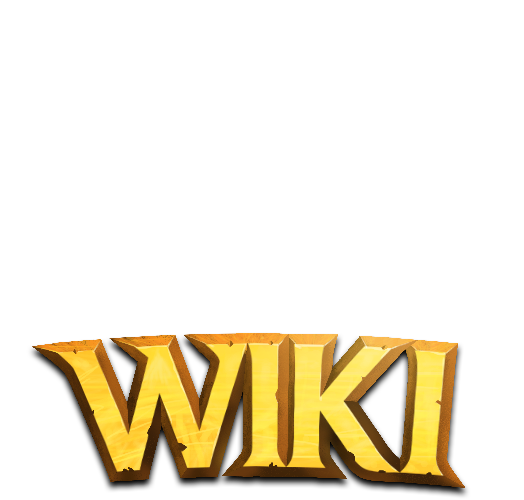From the cut and thrust of glorious battle to the cunning construction of an indomitable deck, this page offers a rough guide to Hearthstone's gameplay.
Matches
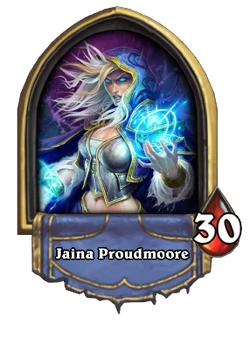
 Jaina Proudmoore, one of the game's heroes
Jaina Proudmoore, one of the game's heroes
Each Hearthstone matches is a 1vs1 battle between two opponents. Gameplay in Hearthstone is turn-based, with players taking turns to play cards from their hand to cast powerful spells, equip mighty weapons, or summon vicious minions to do battle on their behalf. The game may be played between two human players, or one human and an AI computer opponent.
Each player is represented by their chosen 'hero', an important character from Warcraft lore. Each hero is associated with a particular class, which determines the special cards and unique hero power available to them. Each hero has 30 Health, and if their Health is reduced to zero, the hero is destroyed and the controlling player loses the game.
At the start of each turn, the player draws a new card from their deck - a collection of 30 cards selected before battle. Players can choose to play using one of several pre-assembled 'basic' decks, or one of their own custom-made decks. While most cards are available to heroes of any class (neutral cards), a substantial portion of them are limited to a specific class, giving each hero their own strengths and unique abilities.
During their turn, each player can choose to play any of their cards, use their Hero Power, command their minions to attack targets, or even have their hero attack directly if they have a weapon equipped. However, most actions require the player to spend mana, and this limitation forces players to strategically plan out their moves. Each player starts the game with 1 Mana Crystal, and gains one more at the start of each turn until they reach the maximum of 10 Mana Crystals. All of a player's mana regenerates at the beginning of their turn (all their Mana Crystals become 'filled'). Unspent mana remaining at the end of the turn does not carry over to the next. The larger mana pools in later rounds allow players to play increasingly expensive cards, opening the game up to more impressive moves and powerful abilities.
In theory the objective of a game of Hearthstone is simple: reduce the enemy hero's health to zero before they can do so to you. However, the game features multiple strategic elements which require mastery before one can be successful at competitive levels of play. The control of minions, the assignment of strategic importance to various targets, complex card synergies and interactions, as well as the unpredictability of the randomly selected cards drawn each round, combine to create a complex game where the best plays are not always obvious.
Completing a match will grant each player's hero experience, slowly increasing their level, and granting them access to extra cards. While concluding a match will reward both players with experience, winning matches offers additional rewards.
Battlefields
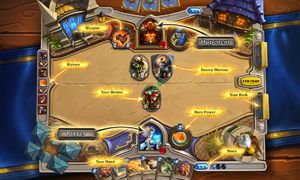
A guide to the main elements of Hearthstone's battlefields.
- Main article: Battlefield
Each match takes place on a randomly selected battlefield, representing the board on which the game is played. There are numerous possible battlefields, each depicting a particular zone or city within the Hearthstone universe. Each battlefield features its own design and numerous interactive elements, but play is in no way affected or determined by battlefield selection. Around the battlefield are various important UI elements, such as each player's hand, deck and Mana Crystals, as well as the two heroes themselves.
Order of play
At the start of each match, a coin is tossed to decide which player will go first. Each player is then shown 3 random cards from their own deck (4 cards for the player going second) that they can either keep or replace individually. Random cards from the deck will be selected to replace those the player discarded, and the discarded cards are reshuffled back into the deck. The player that goes second also receives a special card on their first turn called "The Coin" that can be used at any time to grant the player one extra full Mana Crystal until the end of the turn it is played on. For more details on the card selection stage, see Mulligan.
At the start of each turn, all of the player's Mana Crystals are refilled and one card is drawn from their deck and added to their hand. Players can have a maximum of 10 Mana Crystals, and if the player has less than 10 at the start of the turn they will receive a new filled one. Players can also have up to 10 cards in their hand - attempting to draw a card with a full hand will cause the new card to be revealed to both players and then immediately destroyed.

During your turn you can play any of your cards, including summoning minions, casting spells and equipping weapons, provided you have enough mana. Playing a card will consume the amount of mana stated in the top-left corner of the card. You are also able to command your minions to attack, use your hero's Hero Power, or even use your hero to attack targets directly if your hero has an Attack value this turn (usually granted by having a weapon equipped). Any cards, your Hero Power, or minions that you are currently able to play or command are illuminated with a bright green aura.
Players can end their turn by clicking the End Turn button on the right of the battlefield. If a player has taken every action possible that round, a voice will say "Job's done" and the End Turn button will become illuminated. Each turn lasts a maximum of 75 seconds, plus some non-playable "slush time" at the end to allow animations to complete.[1][2] When the player reaches around the last 20 seconds of the turn, a fuse will appear across the board and start burning down, depicting the remaining time.[3] If it reaches the right side of the field the turn will be automatically ended for the player and it will be the next player's turn.
If a player takes no actions during their turn and the time limit expires, that player's next turn will begin with an even faster burning fuse, giving them around 7 seconds to play.[4] However, as soon as the player takes any action, the fuse will disappear, and the player's turn time will be extended to the usual 75 seconds. In combination, these mechanics force players to think quickly, keeping the game moving at a brisk pace, and prevent non-active players from prolonging a game indefinitely.
Running out of cards to draw does not cause the player to lose. However, once a player has drawn all of their cards, attempts to draw an additional card from their empty deck will cause them to suffer damage from Fatigue. Fatigue initially deals 1 damage to the player, but this amount increases by 1 each time. Players can mouse over their own and their opponent's deck to display how many cards are remaining in each. Players can also mouse over any card or hero power at any time to read its description and view any related enchantments. Mousing over something will highlight it in red on your opponent's screen, and vice versa. Observant players can use this feature to make educated guesses about what cards their opponent might have in their hand.
Conclusion
The match will go on until one of the following goals is achieved:
- One of the heroes' Health reaches zero (or below) and is destroyed. If a hero has become
Lord Jaraxxus, they can be alternatively destroyed by
Sacrificial Pact. The remaining player wins.
- A player concedes or leaves the game. The remaining player wins.
- Both heroes' health reaches zero at the same time. This causes a draw, although both players will see the Defeat screen. Neither player will win or lose a star in Ranked play, and neither player will be awarded a win or loss in Arena mode. If you were on a winning streak, it will end your streak.
- At the beginning of the 90th turn (round 44.5), the game will end in a draw although both players will see the Defeat screen.[5] This means that Player 1 has 45 complete turns (turn 1, 3, 5... 87, 89), while Player 2 has 44 complete turns (turn 2, 4, 6... 86, 88). Player 2 does not start turn 90, will not draw a card and any start of turn triggers will not happen. This bypasses Immune.
Conceding
Players often choose to concede or forfeit the match once they realize they cannot avoid defeat, and can do so at any time through the Game Menu, accessed through the cog-wheel icon in the bottom-right corner of the screen. Conceding can save time spent playing out the final inevitable events of the match, or be used at a far earlier stage in order to avoid wasting time in a match the player feels they cannot win. In some cases, players will concede due to having made a critical error, following which they cannot bring themselves to continue the match.
Cards

One of Hearthstone's many cards
- Main article: Card
Players can initially choose from a selection of more than 130 cards, with 0 cards available in total for players to collect. New cards can be earned in several ways: through increasing the level of their heroes, winning them as prizes in the Arena, purchasing them from the store (using either real money or gold, an in-game currency), earning ranks in Ranked play, or from completing single-player adventures. Cards may be gained individually or in packs of 5.
Players can browse their cards in the Collection screen, and create custom decks to play with. The selection of cards for a deck is a substantial part of the strategic play of Hearthstone, with each deck's 30-card limit forcing players to make tough decisions and focus on their chosen strategy. Players can also disenchant unwanted cards to acquire Arcane Dust, a resource which can be used to craft powerful new cards.
Each card also comes in a golden form. Golden cards offer no gameplay advantage over non-golden cards, but feature special graphics and animations, bringing each card's art to life. Golden cards serve as prestige items, and are more expensive to craft than other cards.
Game modes
- Main article: Game modes
Hearthstone offers several different game modes in which to do battle.
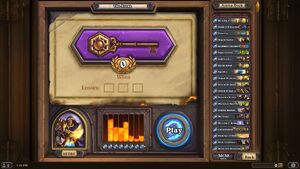
Preparing to play Arena, one of Hearthstone's game modes.
- In Practice mode, players can play against a selection of computer opponents. Players can learn the basics of the game battling against 'basic' opponents, or can put their skills to the test against improved 'expert' opponents.
- Play mode matches players against other human players of similar skill, in random matches. Players can choose to play Casual 'friendly' games, or take part in Ranked play, earning ranks and special rewards to reflect their skill and standing within the community.
- The Arena offers a unique challenge, with players forging a new deck from a random selection of cards before using it to do battle in a series of games. Doing well in Arena can grant substantial rewards consisting of gold, dust, cards and card packs, but each admission costs 150 gold or real money.
- Tavern Brawl is a weekly game mode, with a new Tavern Brawl available each week. Each Tavern Brawl presents a limited time opportunity to face other players in special matches with unique rules. These might be requiring players to use special pre-made decks, adding random cards or minions, or changing the very rules of ability activation or mana use.
- Adventure mode is a single-player game mode in which the player does battle against special computer-controlled bosses, featuring unique hero powers and special cards. Beating these bosses reward the player with cards that cannot be obtained elsewhere as well as unique card backs.
- Players can also choose to issue a Friendly Challenge to a player on their friends list. These unranked matches offer few rewards, save the satisfaction of crushing your friends in combat.
- Spectator mode is an observational mode that allows the player to spectate a match being undertaken by one or two other players. The spectator can see the player's cards and all minions, and can mouse over all interface elements as if in control of the game. However, Spectator mode is purely observational and does not allow the player to affect the match in progress.
The game also features a Tutorial, a limited and non-repeatable starting experience designed to introduce players to Hearthstone.
Game formats
Game formats present two distinct ways to play Hearthstone: Standard, and Wild.
- Standard format is the more balanced and competitive format, and the intended focus for newer players. Aiming to present a fresher and more focused experience, Standard format matches allow only cards from card sets released in the current or previous calendar year, as well as the Basic and Classic sets. Standard format is the default game mode for Play mode.
- Wild format presents an unrestricted playing experience without the deck restrictions of Standard format, allowing the use of cards from any card set. It is the default game mode for the Arena, adventures and almost all Tavern Brawls. However, the format is not unlocked for Play mode until the player has obtained at least one card exclusive to Wild format.
Quests

One of Hearthstone's many quests.
- Main article: Quest
Quests are special objectives players can complete to earn gold, and occasionally special cards. Quests feature criteria such as winning games with a certain class, dealing a certain amount of damage to enemy heroes, or casting a certain number of spells. Players are awarded a new daily quest each day, up to a maximum of three current quests. Quests are the main way for players to earn gold.
Matchmaking
- Main article: Matchmaking
Matches played in Play mode and the Arena use a matchmaking system to determine pairings. Each player has a matchmaking rating, based upon the player's history of games played against other players. In Casual Play mode and the Arena, new players are placed in a special pool with other new players for their first few matches, to ease the transition into the game. The matchmaking process aims to ensure that players face opponents of a similar skill level.
Disconnection and reconnection
If a player is disconnected from Battle.net during a game of Hearthstone, the system will give the player 60 seconds to reconnect to the game, in which case they will immediately be returned to the match they were playing.[6] However, the game will not be paused during disconnections, meaning that returning players may find their turn has expired or the state of the battle has progressed in their absence. Disconnections during the finding opponent process generally cause the queue to be suspended until both players are connected.

If the player is not able to reconnect to the game in time, the game will be concluded in favour of the remaining player. If both players end up disconnected, the game will end in a tie. Players who are unable to reconnect to the game will be informed of the outcome when they log back in.
Disconnection during matches can result in consequences such as experience, gold and Ranked mode stars failing to display at the end of the match. However, although not displayed these are correctly applied, and can be seen in other interface elements such as the Play screen rank indicator and the Quest Log.
Social
Unlike most games, Hearthstone does not have a traditional chat-box. Rather, you can right-click on your character and select specific emotes, such as a verbal taunt, a welcome, well played, or other chat options. Players can also choose to right-click on their opponent to "squelch" them, preventing their emotes from showing. There is also a friends chat function, which allows players on RealID and BattleTag friends lists to talk, regardless of whether they are playing Hearthstone, World of Warcraft, Diablo III or StarCraft II, or simply have the Battle.net launcher open.
Blizzard have stated that their decision to restrict (non-friends list) opponent communication to simple emotes, rather than allowing a full chat function, was in order to reduce potential for harassment, making the game more accessible, and to keep the game flowing at a quicker pace since no one is stopping to type.[7]
Finding opponents
Each player's friends list also displays the BattleTag of the last person they played against, provided they were not a Real ID or BattleTag friend. This allows players who enjoyed their last matching to add their opponent as a friend for future play, or chat.
In addition, the Players Near Me feature allows players to see other players on the same subnet in their friends list, allowing them to challenge local players to battle. Players who are already on the player's friends list will not be shown in the Players Near Me section even if they are on the same subnet. The feature is enabled by default, but can be disabled in the Options menu.
Toasts
When a player completes certain actions, such as opening a legendary card, levelling a hero or finishing an arena run, a 'toast' will be displayed to all players on their friends list announcing their achievement.
Fireside Gatherings
Fireside Gatherings are real-world gatherings of people to play Hearthstone. They are intended to be an opportunity for Hearthstone players to meet, mingle and form real-life friendships, as well as enjoying playing the game face-to-face with some new opponents.
Gatherings can be of any size, and may feature multiple player pools (such as a "novice pool" and an "expert pool") or even mini-tournaments, but are intended to be open to players of all skill levels. With suggested locations of coffee shops, book stores and college dorms, Fireside Gatherings are mostly intended for users of iPads and laptops, although any computer on the same network could be considered part of the event.
Players are actively encouraged to plan and host their own gatherings. For a list of current events, and resources for hosting gatherings, see Fireside Gathering.
Global Play
- Main article: Region
Hearthstone is divided into four geographical regions: Americas, Europe, Asia and China. Each country Hearthstone is available to play in is assigned to one of these regions. Each player by default uses their Battle.net account home region, but can choose to play Hearthstone in other regions if they wish. However, players from the Americas, Europe and Asia regions are currently unable to select the China region for play, and vice versa.
Players can choose their region through the Battle.net launcher, by selecting an option from the drop-down list above the 'Play' button, before launching the game itself. However, players' card collections and game progress are unique to each region, and it is not possible to transfer cards to other regions, meaning that players wishing to try a new region will have to start building a new collection from scratch for that region.
Hearthstone etiquette
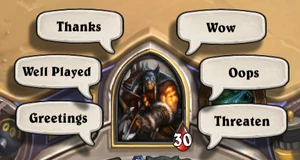
Players can communicate with each other with a range of emotes
- Main article: Hearthstone etiquette
In an exciting game full of surging battle, the explosive destruction of the enemy, and the jeers and cheers of the audience, it's hardly surprising that Hearthstone can bring out less than polite behavior in some players. But what exactly comprises correct or incorrect behavior, and who makes the rules? Hearthstone etiquette explains some of the basic sources of contention and debate within the Hearthstone community regarding player etiquette.
Advanced rulebook
- Main article: Advanced rulebook
While most rules in Hearthstone are fairly easy to ascertain, when several effects, each with their own behaviours, are brought into conflict, things can get a little more complicated. The unofficial Advanced rulebook offers a comprehensive explanation of the game's underlying processes, complete with examples and video references.
Trivia
- The "Job's done" soundbite heard when the player is unable to taken any further actions that turn is taken from Warcraft III. The soundbite is used by the Alliance Peasant unit upon completion of a task such as constructing a building, serving to remind the player to assign the Peasant a new task.
Patch changes
 Patch 3.0.0.9786 (2015-08-18):
Patch 3.0.0.9786 (2015-08-18):
 Patch 1.1.0.6024 (2014-07-22):
Patch 1.1.0.6024 (2014-07-22):
- Additional music tracks have been added.
- Players that appear in “Players Near Me” now appear more prominently within the Friends List.
- Overall organization of the Friends List has been improved.
 Patch 1.0.0.5314 (2014-05-08):
Patch 1.0.0.5314 (2014-05-08):
- Improved friends list sorting based on player status.
- Reconnect functionality has been enabled for Practice mode.
 Patch 1.0.0.4944 (Open beta, 2014-03-11):
Patch 1.0.0.4944 (Open beta, 2014-03-11):
- Secrets can now only activate on your opponent’s turn.
- You can now connect to other regions (Americas, Europe, Korea, Taiwan) of Hearthstone regardless of the region that is set on your Battle.net account. Account progress and card collections are saved separately per region. This feature will become available once the patch is live in all regions.
- The “Players Near Me” feature is now enabled by default. You can disable this feature in the Options Menu.
- If you disconnect from a game, you now have 60 seconds to try and reconnect and pick up from where you left off.
 Patch 1.0.0.4217 (Closed beta, 2013-12-10):
Patch 1.0.0.4217 (Closed beta, 2013-12-10):
- New Feature: Recently played Opponent – Your friends list now displays the last person you played against, provided they were not a Real ID or BattleTag friend. If you had a particularly great match against someone, you can now friend them for future play!
- New Feature: Players Near Me - You can now opt-in to seeing other Hearthstone players on your local network in your friends list.
- User interface:
- The chat UI has received additional improvements.
- Your player rank (icon and number) is now visible in the friends list, the versus screen and your BattleTag in-game.
- The PrintScreen key now takes a screenshot of your game and saves it to your desktop.
References
- ↑ https://www.reddit.com/r/hearthstone/comments/3agk6v/turn_time_has_been_reduced_from_90_to_70_seconds/
- ↑ Ben Brode on Twitter. (2015-09-05).
- ↑ This appears to be around 22.5 seconds, but animation lag makes precise measurement difficult.
- ↑ Full time appears to be 10 seconds, however the remained is wasted in non-playable animation time. Playable time appears to be approximately 7.5 seconds.
- ↑ Patashu (2015-06-07). Maximum Length (in turns) of a Game (Blackrock Mountain Edition).
- ↑ http://us.battle.net/hearthstone/en/blog/13154924/hearthstone-patch-notes-1004944-all-that-glitters-3-11-2014 Hearthstone Patch Notes 1.0.0.4944
- ↑ Hearthpwn.com: Dev Interview - Rating, Social, and Balance Issues; Innkeeper Invitational Spotlight #2
